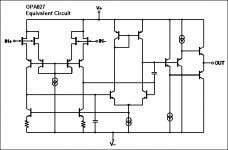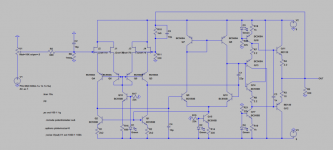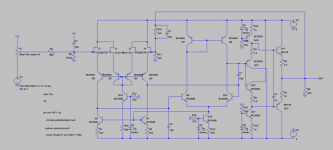OPA827 is now in production and available for sampling.
http://focus.ti.com/docs/prod/folders/print/opa827.html#samples
Give it a shot... this SiGe JFET input opamp is slower than OPA627 but has lower noise, better CMRR and PSRR and lower offset. One to another, and according to my tests, an amazing opamp for audio!
http://focus.ti.com/docs/prod/folders/print/opa827.html#samples
Give it a shot... this SiGe JFET input opamp is slower than OPA627 but has lower noise, better CMRR and PSRR and lower offset. One to another, and according to my tests, an amazing opamp for audio!
Compared to '627 it doesn't have an input cascode any more, drains directly to vcc. It is amazing it has better PSRR and CMRR for my reasoning.😕
darkfenriz said:Compared to '627 it doesn't have an input cascode any more, drains directly to vcc. It is amazing it has better PSRR and CMRR for my reasoning.😕
Transistors in SiGe processes have much higher Early voltage compared to the standard silicon counterparts, so no need for cascoding. Also the SiGe material properties are the secret behind the very low noise spec.
Thanks Ovidiu for explaination
There is still something strange for me.
Why distortion for 3V Vout and 20kHz is bigger for G=1 compared to G=11 ?? (figure 3)
Isn't that dynamic common mode distorion?
Regards,
Adam
There is still something strange for me.
Why distortion for 3V Vout and 20kHz is bigger for G=1 compared to G=11 ?? (figure 3)
Isn't that dynamic common mode distorion?
Regards,
Adam
it would be good to see another decade of frequency - it looks like the G=1 distortion has really taken off above 10 KHz at a much higher rate than the ~ 1 pole response expected from input C modulation interacting with souce/feedback Z imbalance
OPA827 Equivalent Circuit
.
OPA827 is a non-complementary input stage and vas.
Followed by a complementary output buffer
The input uses 4 N-JFETs, in differential configuration.
One JFET pair is used to mirror the bias 'tail current' into the input pair.
The emitter current of input pair is fed into emitters of a pair of PNP BJT.
The load is high impedance, another BJT pair at bottom.
Second stage is a standard differential pair of NPN BJT.
The gain is integrated using PNP mirror at top.
Output stage is one standard complementary diamond buffer.
---------------
The new idea, to me, is the input stage arrangement.
It looks good and interesting 😎
This circuit should be very possible to Clone and Explore using SPICE.
We do not know about what is current level in each stage.
But we know typical supply current is 4.8 mA.
Which gives low current in output stage. Low current Class AB.
The output current is 30 mA and short circuit current 65 mA.
The open loop gain is high; x1,000,000 (+120 dB).
For lowest noise using lower input source resistances OPA211 is mentioned as a better choice.
Lineup
.
OPA827 is a non-complementary input stage and vas.
Followed by a complementary output buffer
The input uses 4 N-JFETs, in differential configuration.
One JFET pair is used to mirror the bias 'tail current' into the input pair.
The emitter current of input pair is fed into emitters of a pair of PNP BJT.
The load is high impedance, another BJT pair at bottom.
Second stage is a standard differential pair of NPN BJT.
The gain is integrated using PNP mirror at top.
Output stage is one standard complementary diamond buffer.
---------------
The new idea, to me, is the input stage arrangement.
It looks good and interesting 😎
This circuit should be very possible to Clone and Explore using SPICE.
We do not know about what is current level in each stage.
But we know typical supply current is 4.8 mA.
Which gives low current in output stage. Low current Class AB.
The output current is 30 mA and short circuit current 65 mA.
The open loop gain is high; x1,000,000 (+120 dB).
For lowest noise using lower input source resistances OPA211 is mentioned as a better choice.
Lineup
Attachments
Pretty straight forward topology. I guess half th e trick in these newer high performance op-amps is in the process - some amazing stuff.
do you know who posted that opa829 clone?nelsonvandal said:I expect it to be a double post. When I bought a new computer this old login started to appear.
It simultates excellent.
Re: OPA827 Equivalent Circuit
I did it a while ago. It simultates very well.lineup said:.
This circuit should be very possible to Clone and Explore using SPICE.
Lineup
Attachments
Re: Re: OPA827 Equivalent Circuit
It appears we have at least three candidates!
Nelson,
Magnus,
Lineup.
Who?
nelsonvandal said:
It was me.
who posted the original?magnusnielsen said:
I did it a while ago. It simulates very well.
It appears we have at least three candidates!
Nelson,
Magnus,
Lineup.
Who?
Re: Re: Re: OPA827 Equivalent Circuit
 . I think Lineups picture is from the TI data sheet.
. I think Lineups picture is from the TI data sheet.
Magnus alias NelsonVandal. A friend of mine gave me that alias. Ever since I was a child I've opened up, examined, modified, and once in a while break thingsAndrewT said:
who posted the original?
It appears we have at least three candidates!
Nelson,
Magnus,
Lineup.
Who?
 . I think Lineups picture is from the TI data sheet.
. I think Lineups picture is from the TI data sheet.Re: Re: Re: Re: OPA827 Equivalent Circuit
1. AndrewT. Is OPA829 same topology as OPA827?
In that case OPA827 Clone is a clone of OPA829, too.
Otherwise we are talking about OPA827 in this topic.
2. My new King is LME49870. 😎
And no, OPA827 can not reach LME49870 😎
Even if OPA827 looks like a very nice op-amp.
3. Yes, NelsonVandal.
My posted image above is only a capture from datasheet simplified circuit.
Lineup
AndrewT said:do you know who posted that opa829 clone?
nelsonvandal said:Has anyone heard it? Will it dethrone AD797 and OPA627/37? Is it a discrete killer?
nelsonvandal said:
I think Lineups picture is from the TI data sheet.
1. AndrewT. Is OPA829 same topology as OPA827?
In that case OPA827 Clone is a clone of OPA829, too.
Otherwise we are talking about OPA827 in this topic.
2. My new King is LME49870. 😎
And no, OPA827 can not reach LME49870 😎
Even if OPA827 looks like a very nice op-amp.
3. Yes, NelsonVandal.
My posted image above is only a capture from datasheet simplified circuit.
Lineup
Re: Re: Re: Re: Re: OPA827 Equivalent Circuit
That's why I asked "who posted the 829 clone".
open the diagram link and you will find that it is titled 829 not 827.lineup said:Is OPA829 same topology as OPA827?
In that case OPA827 Clone is a clone of OPA829, too.
Otherwise we are talking about OPA827 in this topic.
That's why I asked "who posted the 829 clone".
There's no such thing as OPA829. I've posted an AD829 clone before. Both AD829 and the discrete clone sound good. AD829 is very interesting in that you can bypass the diamond buffer, using the compensation pin as output.
Lineup, do you know if LME49870 is different from LME49720/LM4562? I know the sound of the latter two. How would you describe the sound of it?
Lineup, do you know if LME49870 is different from LME49720/LM4562? I know the sound of the latter two. How would you describe the sound of it?
Search forum for LME49860 (dual) LME49870 (single)
Besides the excellent eletrical qualities (Ultra Low Distortion, Very Low Noise)
it is mainly High Operating Voltage which make me like this amplifier.
Compared to LME49710 (single) the LME49870 has 44 Volt vs. 34 Volt.
This is extra 10 Volt to play with.
LME498xx and LME497xx both is a part of National High Performance Audio opamps.
Which means they are specially well suited for signals in the Audio band: 20-20.000 Hertz.
For more info see National catalog, Audio Products:
http://www.national.com/products/catalog.do
About opamp "sounds".
It is my firm belief that any device in an audio chain
with a Signal Distortion les than 0.1 - 0.05 %
will not effect signal quality in a a way any man can hear.
Personally, I do not believe in ghosts either ....... 😀 😀
If I get valid proof of the contrary, I will change my mind.
Now, some nice people are born with a very vivid imagniation.
There is not much we do about this.
They are created not to be guided by any logical thinking.
It is probably something with what half of brain we use.
From following fact, you can draw your own logical conclusions.
Notice that we more often use loads like 10-47 kOhm.
So 600 Ohm is a very heavy audio load 🙂
LME49870 has the following tested THD+N(noise) data
Besides the excellent eletrical qualities (Ultra Low Distortion, Very Low Noise)
it is mainly High Operating Voltage which make me like this amplifier.
Compared to LME49710 (single) the LME49870 has 44 Volt vs. 34 Volt.
This is extra 10 Volt to play with.
LME498xx and LME497xx both is a part of National High Performance Audio opamps.
Which means they are specially well suited for signals in the Audio band: 20-20.000 Hertz.
For more info see National catalog, Audio Products:
http://www.national.com/products/catalog.do
About opamp "sounds".
It is my firm belief that any device in an audio chain
with a Signal Distortion les than 0.1 - 0.05 %
will not effect signal quality in a a way any man can hear.
Personally, I do not believe in ghosts either ....... 😀 😀
If I get valid proof of the contrary, I will change my mind.
Now, some nice people are born with a very vivid imagniation.
There is not much we do about this.
They are created not to be guided by any logical thinking.
It is probably something with what half of brain we use.
From following fact, you can draw your own logical conclusions.
Notice that we more often use loads like 10-47 kOhm.
So 600 Ohm is a very heavy audio load 🙂
LME49870 has the following tested THD+N(noise) data
THD+N (AV = 1, VOUT = 3VRMS, f-IN = 1kHz)
RL = 2kΩ 0.00003% (typ)
RL = 600Ω 0.00003% (typ)
---------
😎 note * 0.1 % vs. 0.00003 % is a difference of 70 dB sound level in your Speakers
- Status
- Not open for further replies.
- Home
- Amplifiers
- Solid State
- OPA827 available



